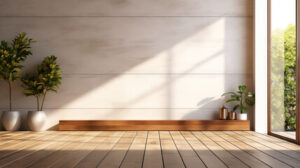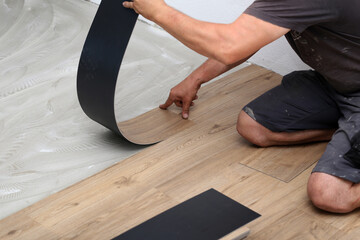Choosing the Right Flooring for Your Home
Flooring is a big decision that affects the whole room. It sets the stage for your design style, comfort, and function. After the mortar layer has hardened slightly, a cement slurry is applied. Tile flooring is durable and reparable and adds value to your home. However, it can be cold in winter if not insulated properly.
Thompson & Boys LLC adds a rich, warm look to any home. It is durable and can be refinished to renew its beauty and extend its life. Because it is a natural product, wood floors are more environmentally friendly than synthetic flooring made from plastic and vinyl1.

Different hardwood species have different properties that influence how well they hold up to everyday wear and tear. Some have a higher Janka rating than others, which indicates how much force is needed to dent or scratch them. Hardwoods with a high Janka rating include oak, maple, and hickory, while those with lower ratings (like cherry, teak, and Douglas fir) are more sensitive to scratches.
How a hardwood floor is milled, cut, and finished also impacts its durability. Unlike laminate and vinyl, solid hardwood can be sanded and refinished several times, giving it a longer lifespan than many other types of flooring. Solid wood floors have a thicker wear layer than engineered wood and can be installed on any subfloor, including concrete.
Solid hardwood is milled from planks of timber that are kiln or air-dried before being sawed into boards. It can be cut using two primary methods, determining the appearance of the wood grain: flat-sawn and quarter-sawn. Flat-sawn boards are sliced lengthwise, allowing the growth rings to appear parallel to the board’s surface. Quarter-sawn panels are cut perpendicular to the grain, creating a distinctive wavy or flamel-like pattern.
A hardwood floor can be finished with a wax, polyurethane, or oil-based stain to protect it from scuffing and scratches. It can also be sanded and refinished several times, making it an enduring, beautiful choice for any room in the house.
When choosing a wood finish, be sure to select one that is certified by the Forest Stewardship Council. These sealers help ensure that the wood is harvested and manufactured in an environmentally responsible manner. Some manufacturers also use aluminum oxide finishes to make their products more durable and resistant to scuffing. These finishes are packed with aluminum oxide and cured under UV light at the factory, making them tougher than the ones applied on-site.
Carpet adds warmth and texture to your home, transforming living spaces by creating cozy, insulated rooms. This floor covering is available in various colors, materials, and styles, making it versatile enough to complement any design aesthetic.
It is an affordable option that is easy to maintain. Regular sweeping and vacuuming remove loose dirt and debris, and periodic damp mopping with a wood cleaner removes more stubborn soiling. It is less likely to trap dirt, allergens, and dust than hardwood floors, reducing respiratory irritation for allergy sufferers. Carpet can also reduce acoustic noise and insulate spaces with high ceilings or large windows.
The layered structure of modern carpets helps dampen sound, which can be particularly beneficial in commercial spaces such as office environments, call centers, and crowded bars or restaurants. In addition, carpet offers comfort underfoot and can generate a soothing sensation when walking over it for long periods.
A carpet is a durable floor covering lasting several years, providing a good return on investment. Carpet can also help to reduce energy bills by retaining heat in spaces with higher ceilings or large windows.
It can be made from a variety of natural or synthetic fibers. Wool carpets are the most desirable, offering a premium feel and thermal resistance. Wool is also naturally fire-resistant and breathable, which makes it an ideal choice for public spaces.
The versatility of carpet allows designers to create a unique look for each space. Whether woven on a loom, needle felts, or knotted by hand (in oriental rugs), the possibilities for creative expression are endless. Carpet can be produced with small motifs, patterns, or logos on flat areas and stairs or with borders and edging to complement the decor of a more luxurious installation.
The lifespan of hard flooring is shorter than that of carpet, and re-upholstery costs are typically 21/2 times those of carpet over the same period. Additionally, removing old adhesive is a messy, dusty operation that can be hazardous to health. Conversely, carpets can be installed with a Doublestick or Release system that eliminates the need for sanding and provides a safe environment to work in.
Tile flooring is a broad term for tough, durable floors that are cut into tiles with the spaces between them filled with grout. Tile is made from stone, ceramic, or porcelain (glazed ceramic) and is available in various colors, patterns, and textures. It’s a good choice for kitchens, bathrooms, and foyers but is also used effectively in living areas and bedrooms.
Tile is generally a low-maintenance floor material, though the grout seams can collect dirt and mildew if not regularly sealed. Choosing a high-quality product from a reputable manufacturer is important to ensure that your tile floor will last for as long as you own your home. Popular manufacturers
In addition to a long lifespan, tile provides an excellent return on investment, adding to the value of your home. As such, it’s a common feature in luxury homes. However, this luxurious floor option can add a costly price tag to your renovation.
When choosing tile, consider a variety of styles and colors to create an aesthetic that is uniquely yours. Mix and match different tile types to create a flooring design that complements your furniture and decor. For example, the textured, earthy beauty of travertine tile makes it a natural-looking alternative to hardwood or carpet.
Another hard tile option is pure concrete paver tiles, colored and textured to resemble quarry tile. These are often used in outdoor areas for walkways, patios, and pool decking but can be brought indoors to mudrooms, laundry rooms, and utility rooms, which work well because of their rugged durability. They can also work in living rooms and bedrooms but are better suited to a casual or rustic style. They’re fairly easy for DIYers to install themselves.
Stone flooring is a classic look that adds value to your home. It is durable and can withstand high humidity, making it an excellent choice for bathrooms and basements. It can also complement any design theme. It is important to note that stone is heavy and requires professional installation. A skilled installer will ensure the floor is level and can withstand the weight.
There are several types of stone flooring, including natural and engineered stone. Natural stone is quarried and cut from the earth and may look more rustic. It comes in various colors and textures, so there is an option to match any decor. One thing to consider with natural stone is that it can be quite porous, so it must be sealed regularly to prevent moisture damage.
Engineered stone is manufactured in factories using a combination of limestone, quartz, or marble and a polymer resin adhesive. This product is durable, less expensive than natural stone, and easy to install. It can also be grouted, which is an advantage for some homeowners. It is best suited for low to medium-traffic areas and can be used with radiant heating systems.
The cost of stone floors varies widely depending on the type and size of tile and installation costs. It is also essential to factor in future maintenance costs. A stone floor must be resealed every four to five years, which can be costly.
While all stone is considered a hardwearing material, deciding how durable you need your flooring to be is important. Consider the amount of foot traffic and whether there will be any spills or pet accidents. Also, determine whether you want the floor to be a feature or a practical space. A textured surface will be more resilient than a smooth finish but will also show dirt more readily.
Most natural stone has a standard grade system that determines the quality of the material. Grade-1 stones have a uniform color and pattern with few flaws and are suitable for use as flooring. Grade-2 stones are more varied and include pits, blemishes, and mineral inclusions. These are generally used for wall cladding or as rustic decoration. Grade-3 stones have major flaws and are only suitable for outdoor use or as accent pieces.

